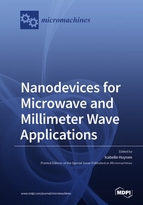Nanodevices for Microwave and Millimeter Wave Applications
A special issue of Micromachines (ISSN 2072-666X). This special issue belongs to the section "A:Physics".
Deadline for manuscript submissions: closed (31 May 2019) | Viewed by 22462
Special Issue Editor
Interests: microwave and millimeter wave; nanotechnotechnology; modeling; simulation; measurement; broadband nanodevices
Special Issues, Collections and Topics in MDPI journals
Special Issue Information
Dear Colleagues,
Inspired initially by the work of Richard Feynman in 1959, and his famous talk “There is plenty of room at the bottom”, predicting that manipulating and controlling things on a small scale would have an enormous number of applications, nanoscience and nanotechnology moved during the 2000s from laboratory developments to daily life applications. The nanoworld, as understood today, is at the frontier between the level of atoms and molecules, governed by quantum physics, and the macroworld, where materials have bulk properties resulting from the assembly of billions of atoms. The general idea underlying the “nano” concept is that studying or rearranging matter at the molecular or atomic level will yield electrical, chemical, mechanical or optical properties that are superior to those of the bulk material.
On the other hand, the microwave and millimeter wave frequency range is nowadays widely exploited in a large variety of fields including (wireless) communications, security, radar, spectroscopy, but also astronomy and biomedical, to name a few.
This Special Issue focuses on the interaction between the nanoscale dimensions and centimeter to millimeter wavelengths. This interaction has been proven to be efficient for the design and fabrication of devices showing enhanced performance. Novel contributions are welcome in the field of devices based on nanoscaled geometries and materials. Applications cover, but not are limited to, electronics, sensors, signal processing, imaging and metrology, all exploiting nanoscale/nanotechnology at microwave and millimeter waves.
Contributions can take the form of short communications, regular or review papers.
Prof. Isabelle Huynen
Guest Editor
Manuscript Submission Information
Manuscripts should be submitted online at www.mdpi.com by registering and logging in to this website. Once you are registered, click here to go to the submission form. Manuscripts can be submitted until the deadline. All submissions that pass pre-check are peer-reviewed. Accepted papers will be published continuously in the journal (as soon as accepted) and will be listed together on the special issue website. Research articles, review articles as well as short communications are invited. For planned papers, a title and short abstract (about 100 words) can be sent to the Editorial Office for announcement on this website.
Submitted manuscripts should not have been published previously, nor be under consideration for publication elsewhere (except conference proceedings papers). All manuscripts are thoroughly refereed through a single-blind peer-review process. A guide for authors and other relevant information for submission of manuscripts is available on the Instructions for Authors page. Micromachines is an international peer-reviewed open access monthly journal published by MDPI.
Please visit the Instructions for Authors page before submitting a manuscript. The Article Processing Charge (APC) for publication in this open access journal is 2600 CHF (Swiss Francs). Submitted papers should be well formatted and use good English. Authors may use MDPI's English editing service prior to publication or during author revisions.
Keywords
- Nanotechnology
- Microwaves
- Millimeter Wave
- Nanoscopic Devices
- Nanomaterials
- Modelling
- Fabrication
- Measurement







